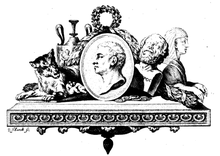Of the apparent simplicity and flowing ease of the classic writers, how justly does Horace remark;
ut sibi quivis
Speret idem, sudet multúm,
frustraque laboret ausus idem:
tantum series iuncturaque pollet, tantum de medio
Search Results
[PPT]Horace : Ars Poetica (the Art of Poetry) - Pyrrha's Roman Pages
www.pyrrha.rtwilson.com/utpicturaHoraceVirgilCatullus.pptx
speret idem, sudet multum frustraque laboret. ausus idem : I will aim for poetry moulded from the familiar so that if anyone. wants the same for himself, he may ...Masterwork[edit]
Winckelmann's masterpiece, the Geschichte der Kunst des Alterthums ("The History of Art in Antiquity"), published in 1764, was soon recognized as a permanent contribution to European literature. In this work, "Winckelmann's most significant and lasting achievement was to produce a thorough, comprehensive and lucid chronological account of all antique art— including that of the Egyptians and Etruscans."[14] This was the first work to define in the art of a civilization an organic growth, maturity, and decline. Here, it included the revelatory tale told by a civilization's art and artifacts—these, if we look closely, tell us their own story of cultural factors, such as climate, freedom, and craft. Winckelmann sets forth both the history of Greek art and of Greece. He presents a glowing picture of the political, social, and intellectual conditions which he believed tended to foster creative activity in ancient Greece.
The fundamental idea of Winckelmann's artistic theories are that the end of art is beauty, and that this end can be attained only when individual and characteristic features are strictly subordinated to an artist's general scheme. The true artist, selecting from nature the phenomena suited to his purpose and combining them through the exercise of his imagination, creates an ideal type in which normal proportions are maintained, and particular parts, such as muscles and veins, are not permitted to break the harmony of the general outlines.
Geschichte der Kunst des Alterthums ("The History of Art in Antiquity",
論古代藝術 邵大箴譯,北京:中國人民大學出版社,1989
可惜專有名詞全是漢文,無原文。。
原書插圖為
原書插圖為

北京版採用:

他為考古學奠基。溫克爾曼是文藝復興人文主義者Flavio Biondo的追隨者,因此自稱義大利人文主義者。Biondo以前為古董收藏者,因此溫克爾曼的古物藝術的藝術史學方法也是跟隨著Biondo。溫克爾曼的藝術評價成為美學的基礎。


沒有留言:
張貼留言